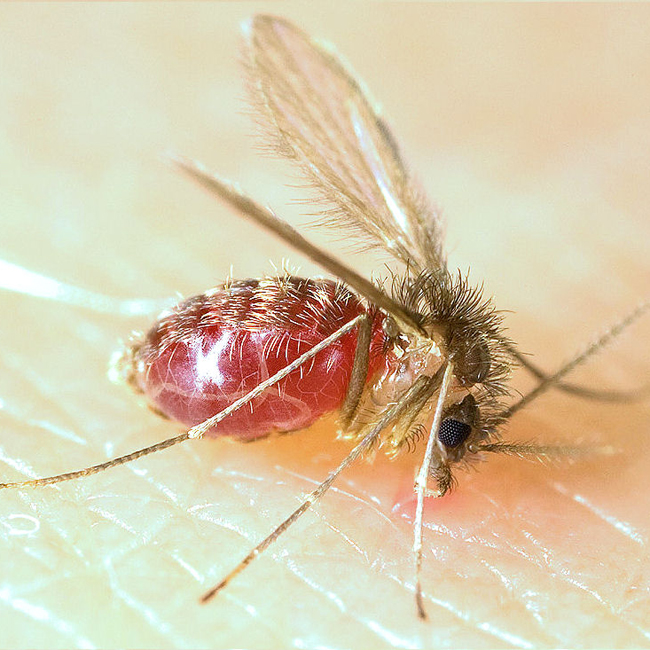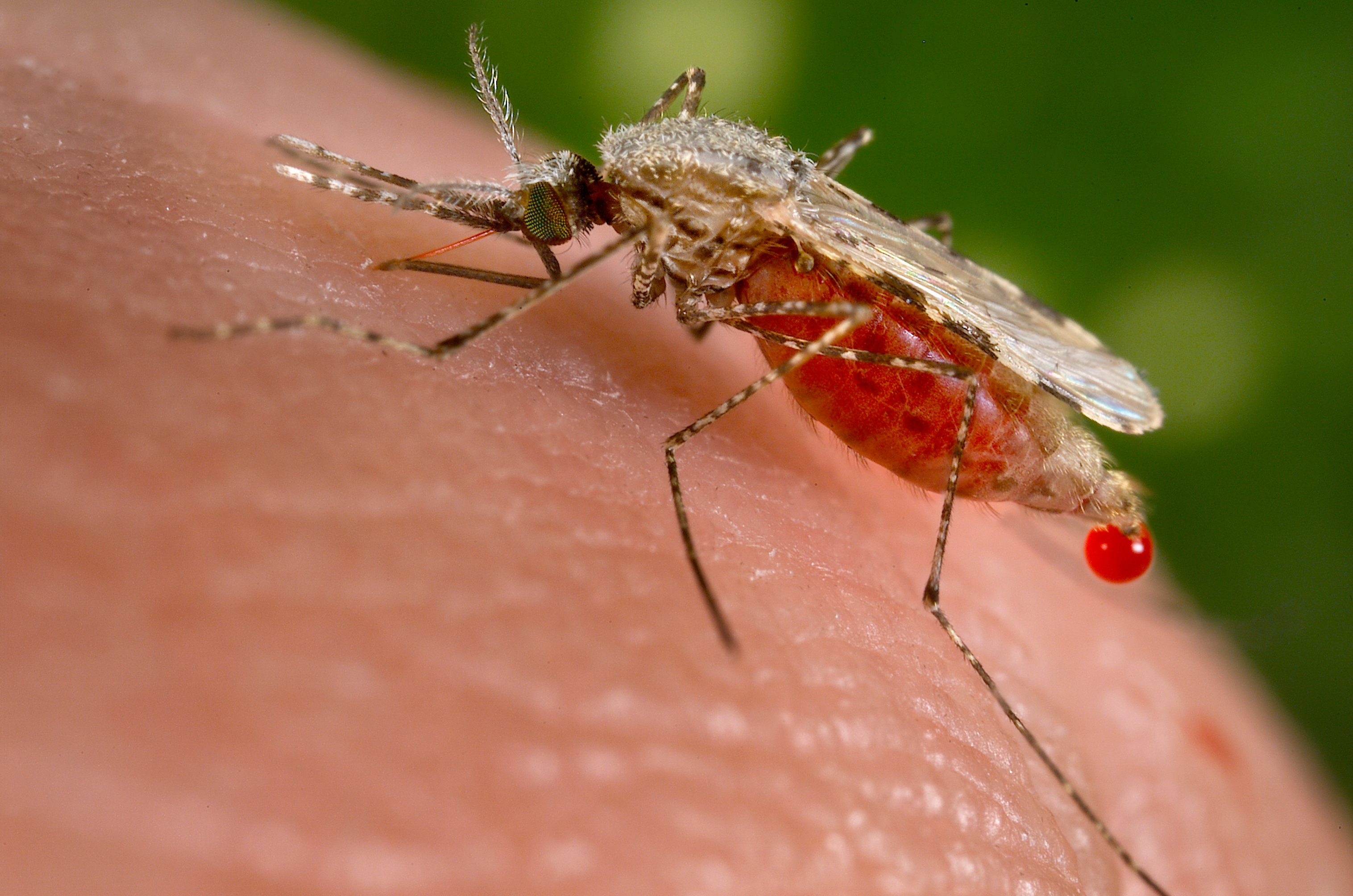|
Phlebotominae
The Phlebotominae are a subfamily of the family Psychodidae. In several countries, their common name is sandfly, but that name is also applied to other flies. The Phlebotominae include many genera of blood-feeding ( hematophagous) flies, including the primary vectors of leishmaniasis, bartonellosis, and pappataci fever. Sandflies are small; a body size of about 3 mm in length is typical for many species, which aids them in escaping notice. Their bite is not always felt, but leaves a small, round, reddish bump that starts itching hours or days later. Use of insect repellent is recommended in areas where sandflies are present. Diet and reproduction Phlebotomine sandflies have a diet that includes both blood and plant-derived sugar meals. Phlebotomine females, and only females, suck blood from various mammals, reptiles, and birds, while both sexes consume sugary substances including nectar, honeydew, and phloem sap from plants. Some species are selective about their hosts, ... [...More Info...] [...Related Items...] OR: [Wikipedia] [Google] [Baidu] |
Psychodidae
Psychodidae, also called drain flies, sink flies, filter flies, sewer flies, or sewer gnats, is a Family (biology), family of Fly, true flies. Some genera have short, hairy bodies and wings, giving them a "furry" moth-like appearance, hence one of their common names, moth flies. Members of the sub-family Phlebotominae, which are hematophagous (feed on blood), may be called sand flies in some countries, although this term is also used for other unrelated flies, such as horse flies (Tabanidae) and no-see-ums (Ceratopogonidae). There are more than 2,600 described species worldwide, most of them native to the humid tropics. This makes them one of the most diverse families of their order. Drain flies sometimes inhabit plumbing drains and sewage systems, where they are harmless, but may be a persistent annoyance. Life cycle The larvae of the subfamilies Psychodinae, Sycoracinae and Horaiellinae live in aquatic to semi-terrestrial or sludge-based habitats, including bathroom sinks, ... [...More Info...] [...Related Items...] OR: [Wikipedia] [Google] [Baidu] |
Phlebotomus Papatasi
''Phlebotomus papatasi'' is a species of insects commonly known as Phlebotominae, sandflies. Due to their ectothermic climate limitations, ''P. papatasi'' are confined to regions with temperatures above 15 degrees Celsius for at least three months of the year, spanning over much of the European Mediterranean, North Africa, the Middle East, and Central Asia. Around one thousand sandfly species have been described, belonging to the subfamily ''Phlebotominae'' within the family ''Psychodidae''. The ''Psychodidae'' family belongs to the order ''Diptera'' within the class ''Insecta'' of the subphylum ''Hexapoda'' of the ''Arthropod'' phylum. ''Phlebotomus papatasi'' are translucent light brown in color, with two large, black compound eyes, six long legs, a transparent abdomen and antenna (zoology), antennae each comprising a scape, pedicel and flagellum, totaling the sandfly's size to less than four millimeters in length. Small hairs cover the entire body and wings, which are constantl ... [...More Info...] [...Related Items...] OR: [Wikipedia] [Google] [Baidu] |
Leishmaniasis
Leishmaniasis is a wide array of clinical manifestations caused by protozoal parasites of the Trypanosomatida genus ''Leishmania''. It is generally spread through the bite of Phlebotominae, phlebotomine Sandfly, sandflies, ''Phlebotomus'' and ''Lutzomyia'', and occurs most frequently in the tropics and sub-tropics of Africa, Asia, the Americas, and southern Europe. The disease can present in three main ways: Cutaneous leishmaniasis, cutaneous, mucocutaneous leishmaniasis, mucocutaneous, or visceral leishmaniasis, visceral. The cutaneous form presents with skin ulcers, while the mucocutaneous form presents with ulcers of the skin, mouth, and nose. The visceral form starts with skin ulcers and later presents with fever, low red blood cell count, and enlarged spleen and liver. Infections in humans are caused by more than 20 species of ''Leishmania''. Risk factors include poverty, malnutrition, deforestation, and urbanization. All three types can be diagnosed by seeing the paras ... [...More Info...] [...Related Items...] OR: [Wikipedia] [Google] [Baidu] |
Sandfly
Sandfly or sand fly is a colloquial name for any species or genus of flying, biting, blood-sucking dipteran (fly) encountered in sandy areas. In the United States, ''sandfly'' may refer to certain horse flies that are also known as "greenheads" (family '' Tabanidae''), or to members of the family ''Ceratopogonidae''. The bites usually result in a small, intensely itchy bump or welt, the strength of which intensifies over a period of 5-7 days before dissipating. Sandfly bites can be distinguished from mosquito bites as sandfly bite are usually found in clusters as they attack animals in groups. Moderate relief is achieved with varying success through the application of over-the-counter products such as Benadryl (ingested) or an analgesic cream such as After Bite (applied topically). Outside the United States, ''sandfly'' may refer to members of the subfamily Phlebotominae within the Psychodidae. Biting midges (Ceratopogonidae) are sometimes called sandflies or no-see-ums ... [...More Info...] [...Related Items...] OR: [Wikipedia] [Google] [Baidu] |
Lutzomyia Longipalpis-sandfly
''Lutzomyia'' is a genus of phlebotomine sand flies consisting of nearly 400 species, at least 33 of which have medical importance as vectors of human disease. Species of the genus ''Lutzomyia'' are found only in the New World, distributed in southern areas of the Nearctic and throughout the Neotropical realm. ''Lutzomyia'' is one of the two genera of the subfamily Phlebotominae to transmit the Leishmania parasite, with the other being ''Phlebotomus'', found only in the Old World. ''Lutzomyia'' sand flies also serve as vectors for the bacterial Carrion's disease and a number of arboviruses. Evolution The genus, named after Adolfo Lutz, is known from the extinct Burdigalian (20–15 mya) species ''Lutzomyia adiketis'' found as a fossil in Dominican amber on the island of Hispaniola. It is thought that species in the genus ''Lutzomyia'' all originated in the lowland forests to the east of the Andes mountain range, and that their radiation throughout the Neotropics was spar ... [...More Info...] [...Related Items...] OR: [Wikipedia] [Google] [Baidu] |
Lutzomyia
''Lutzomyia'' is a genus of Phlebotominae, phlebotomine Sandfly, sand flies consisting of nearly 400 species, at least 33 of which have medical importance as Vector (epidemiology), vectors of human disease. Species of the genus ''Lutzomyia'' are found only in the New World, distributed in southern areas of the Nearctic realm, Nearctic and throughout the Neotropical realm. ''Lutzomyia'' is one of the two genera of the subfamily Phlebotominae to transmit the Leishmania parasite, with the other being ''Phlebotomus'', found only in the Old World. ''Lutzomyia'' sand flies also serve as vectors for the bacterial Oroya fever, Carrion's disease and a number of arboviruses. Evolution The genus, named after Adolfo Lutz, is known from the extinct Burdigalian (20–15 Mya (unit), mya) species ''Lutzomyia adiketis'' found as a fossil in Dominican amber on the island of Hispaniola. It is thought that species in the genus ''Lutzomyia'' all originated in the lowland forests to the east of t ... [...More Info...] [...Related Items...] OR: [Wikipedia] [Google] [Baidu] |
Pappataci Fever
Pappataci fever (also known as phlebotomus fever and, somewhat confusingly, sandfly fever and three-day fever) is a vector-borne febrile arboviral infection caused by three serotypes of Phlebovirus. It occurs in subtropical regions of the Eastern Hemisphere. The name, pappataci fever, comes from the Italian word for sandfly; it is the union of the words ''pappa'' (usually this is used as a generic name for food, but in this case it is a ''verb'' meaning "eating") and ''taci'' (silent), distinguishing these insects from blood-feeding mosquitoes, which produce a typical noise while flying. Signs and symptoms A few days after the infective bite, a feeling of lassitude, abdominal distress and chills develop followed by fever of , severe frontal headaches, muscle and joint aches, flushing of the face and a fast heart rate. After two days the fever begins to subside and the temperature returns to normal. Fatigue, a slow heart rate and low blood pressure may persist from a few days ... [...More Info...] [...Related Items...] OR: [Wikipedia] [Google] [Baidu] |
Vector (epidemiology)
In epidemiology, a disease vector is any living agent that carries and transmits an infectious pathogen such as a parasite or microbe, to another living organism. Agents regarded as vectors are mostly blood-sucking (Hematophagy, hematophagous) arthropods such as mosquitoes. The first major discovery of a disease vector came from Ronald Ross in 1897, who discovered the malaria pathogen when he dissected the stomach tissue of a mosquito. Arthropods Arthropods form a major group of pathogen vectors with mosquitoes, Fly, flies, Sandfly, sand flies, lice, fleas, ticks, and mites transmitting a huge number of pathogens. Many such vectors are haematophagous, which feed on blood at some or all stages of their lives. When the insects and ticks feed on blood, the pathogen enters the blood stream of the host. This can happen in different ways. The ''Anopheles'' mosquito, a vector for malaria, filariasis, and various arthropod-borne-viruses (arboviruses), inserts its delicate mouthpart under ... [...More Info...] [...Related Items...] OR: [Wikipedia] [Google] [Baidu] |
Histamine
Histamine is an organic nitrogenous compound involved in local immune responses communication, as well as regulating physiological functions in the gut and acting as a neurotransmitter for the brain, spinal cord, and uterus. Discovered in 1910, histamine has been considered a local hormone ( autocoid) because it is produced without involvement of the classic endocrine glands; however, in recent years, histamine has been recognized as a central neurotransmitter. Histamine is involved in the inflammatory response and has a central role as a mediator of itching. As part of an immune response to foreign pathogens, histamine is produced by basophils and by mast cells found in nearby connective tissues. Histamine increases the permeability of the capillaries to white blood cells and some proteins, to allow them to engage pathogens in the infected tissues. It consists of an imidazole ring attached to an ethylamine chain; under physiological conditions, the amino grou ... [...More Info...] [...Related Items...] OR: [Wikipedia] [Google] [Baidu] |
Phlebotomus
''Phlebotomus'' is a genus of " sand flies" in the Diptera family Psychodidae. In the past, they have sometimes been considered to belong in a separate family, Phlebotomidae, but this alternative classification has not gained wide acceptance. Epidemiology In the Old World, ''Phlebotomus'' sand flies are primarily responsible for the transmission of leishmaniasis, an important parasitic disease, while transmission in the New World, is generally via sand flies of the genus '' Lutzomyia''. The protozoan parasite itself is a species of the genus ''Leishmania''. Leishmaniasis normally finds a mammalian reservoir in rodents and other small animals such as canids ( canine leishmaniasis) and hyraxes. The female sand fly carries the ''Leishmania'' protozoa from infected animals after feeding, thus transmitting the disease, while the male feeds on plant nectar. The parasite ''Leishmania donovani'' is the main causative agent of visceral leishmaniasis (VL) in India, Nepal, and Banglad ... [...More Info...] [...Related Items...] OR: [Wikipedia] [Google] [Baidu] |
Oskar Theodor
Oskar Theodor (; 3 October 1898 – 1987) was an Israeli entomologist who specialised in Diptera. Born in Königsberg, East Prussia (now Kaliningrad, Russia) he came to pre-Israel Palestine following a year's service as an orderly in the Imperial German Army in World War I. In 1921 he became an assistant in the Government of Palestine Department of Health, and in 1923 he transferred to the Malaria Research Unit in Haifa. In 1925 he became an assistant in the Department of Parasitology in the University of Jerusalem, where he remained for the rest of his career. In 1928, Oskar Theodor returned briefly to Königsberg to complete his Ph.D. in entomology at the University of Königsberg The University of Königsberg () was the university of Königsberg in Duchy of Prussia, which was a fief of Poland. It was founded in 1544 as the world's second Protestant Reformation, Protestant academy (after the University of Marburg) by Duke A .... References 1898 births 1987 deaths D ... [...More Info...] [...Related Items...] OR: [Wikipedia] [Google] [Baidu] |





